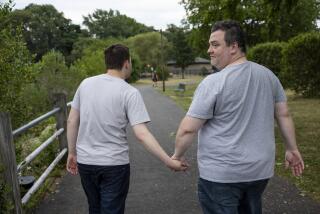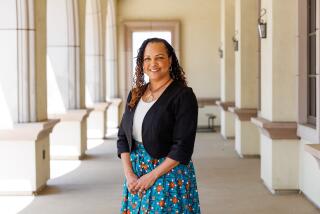Calming Down : Behavior: A 9-month-old program provides a one-stop setting of education and therapy to help hyperactive children.
- Share via
Mark Thompson is an appealing, freckle-faced boy who loves to play and draws pictures of startling insight for an 11-year-old.
But Mark has been neither a joy to raise nor a pleasure to teach. His parents paint a grim picture of Mark’s elementary school years and note that his first-grade teacher still shudders when she hears his name.
For the record:
12:00 a.m. June 2, 1990 For the Record
Los Angeles Times Saturday June 2, 1990 Orange County Edition Orange County Life Part N Page 3 Column 1 Life Desk 1 inches; 25 words Type of Material: Correction
Hyperactive children--A story Thursday on hyperactive children reported an incorrect cost for the program at the UC Irvine child development center. Daytime care costs $243.
For the Record
Los Angeles Times Monday June 4, 1990 Home Edition View Part E Page 8 Column 3 View Desk 1 inches; 32 words Type of Material: Correction
Hyperactive care--Due to misinformation supplied to The Times, a May 31 article in View incorrectly reported the cost of a program for hyperactive children at the Child Development Center of UC Irvine. The cost is $243 per day.
Mark is one of those “hyper” kids, the one in a room of 30 students who won’t stay in his seat, refuses to follow directions and picks a fight over the most trivial of issues. Everyone seems to know a kid like Mark, but the reality is that more misinformation and misunderstanding swirl around the label hyperactive than thoughtful treatment of the disorder.
Sue and Dave Thompson were luckier than many parents of hyperactive children in that they found their way early to doctors who accurately diagnosed Mark’s problem. But a treatment that produced adequate results eluded them until last fall, when Mark entered an unusual program combining special educational services for hyperactive youngsters with the medical and psychiatric treatment many of them need.
The program is a joint venture between the child development center of UC Irvine and Newport Harbor, a private adolescent psychiatric hospital in Newport Beach.
Expected by its proponents to be a model for such efforts nationally, the 9-month-old program seeks to combine in one setting every form of education and therapy known to work with hyperactive children. The goal is to intervene early and comprehensively to save them from often crippling school and social failures.
It will be several years before long-term results of the program’s intensive, five-day-a-week curriculum are known. The Thompsons, nevertheless, are enthusiastic, having seen dramatic improvement in Mark’s self-esteem and in his willingness to take responsibility for schoolwork and behavior.
Says Dave Thompson: “The people at UCI are so caring and concerned about him that they don’t make mistakes and with a wrong word knock the legs out from under him.”
Hyperactivity is believed to result from a brain condition, present at birth, that makes afflicted children unable to control their impulses or focus on a school lesson or other task.
The condition has been called many things, but the proper medical term today is attention-deficit hyperactivity disorder or ADHD. Various estimates suggest that from 3% to 10% of elementary school-age children are afflicted. They face a gloomy future, with extremely high school dropout rates, as well as problems with alcoholism, drug abuse, even criminal behavior later in life.
For years the treatment has depended greatly on the controversial drug Ritalin (methylphenidate), a powerful stimulant that paradoxically has a calming effect on pre-pubescent children. The Ritalin controversy flared anew two years ago when there emerged evidence of excessive and indiscriminate use on children who may have acted up in school but lacked the medical history or supervision to justify medication.
The drug has also been criticized for masking the underlying problems of ADHD, and few specialists today would recommend its use without accompanying therapy for behavioral and emotional problems.
“ADHD has enormous emotional implications,” says Dr. Paul Hoernig, a child psychiatrist at Newport Harbor who treats Mark and meets regularly with his parents. “These children have a higher degree of learning disorders, fine motor and coordination problems, dyslexia (a neurological reading handicap). All of these problems, unfortunately, feed on one another. Sending a child home with 2,000 Ritalin tablets just doesn’t make it.”
Mark is the youngest of the seven children brought together when the Thompsons married six years ago. He is Dave Thompson’s fourth child; Sue has two grown sons and a teen-age daughter. Until Dave and Sue married, Mark and his brother, Matt, now 13, lived primarily with their paternal grandparents. But Sue Thompson says she often had the boys over to her house on weekends during those early years and felt she got to know them well even before she became their stepmother.
“Mark was always what I thought of as the perfect baby--happy, loving, contented,” Sue Thompson recalls. “Then he started preschool.”
There he began to show the behavior that labeled him a problem student throughout his elementary years. He was fine when left alone to play as he wished. He was uncooperative whenever someone tried to get him to do something else. And he did not respond to discipline.
In kindergarten, his behavior worsened, but the Thompsons attributed that to their recent marriage and the upheaval it produced in young Mark’s life. He and Matt moved from their grandparents’ house to the Thompsons’ home in Huntington Beach and started a new school. But while Matt seemed to adjust, Mark held himself apart, defiant. He refused to call Sue Thompson “Mom” as his brother did, and neither punishment nor reward influenced his behavior.
By the end of kindergarten, he had become so disruptive at home and in school that the Thompsons decided to consult a child psychologist. The psychologist immediately suspected ADHD, and testing confirmed his hunch. Mark was put on Ritalin.
It helped his concentration somewhat, but his behavior continued to worsen through first grade. He refused to do homework. His standard responses to most requests or suggestions at home were “I don’t care,” “I can’t do it” or “I won’t.” When things didn’t go his way, the reproach he hurled at every family member was “You don’t love me.”
“As time went on, it was ‘I don’t care and I’m going to kill myself and you wouldn’t care,’ ” Sue Thompson recalls.
Because Mark scored high on intelligence tests administered at school, it was very difficult to get remedial help, counseling or behavioral training through the school, the Thompsons say.
Dave Thompson, who, as an administrator at Marina High School in Huntington Beach, is better equipped than most for such bureaucratic battles, described the effort as “extremely frustrating.”
The problem was Mark’s label: He was classified as a behavior problem, not learning disabled, and most of the services outside the classroom were for the children in the latter group.
As he got older and bigger, Mark became less manageable. His uncooperativeness in school turned menacingly aggressive. He would tip over a desk rather than sit down and do a reading lesson. With other children, he mostly engaged in fistfights.
“You could tell him his shirt was ugly and that would be enough for him to tear into you,” Dave Thompson says.
The second through fourth grades were marked by repeated calls from school officials reporting Mark’s latest misbehavior. His grades deteriorated. He could barely read.
At home, the battles were constant. He became withdrawn and unable to articulate any feelings, even when his adored grandfather died, then his grandmother, slowly, of cancer.
In desperation, the Thompsons had Mark admitted for 10 weeks to the children’s psychiatric unit of UCI Medical Center, hoping someone there could unravel the mystery of him. They took special classes at the hospital to learn how to better manage Mark’s outbursts at home. His Ritalin dose was adjusted, but fundamentally, Mark remained unchanged.
A consultation with an expert in ADHD led the Thompsons last fall to the UCI-Newport Harbor program, at the university’s Child Development Center in Irvine. Mark entered fifth grade there.
The school part of the program is run by the university. It covers kindergarten through fifth grade, with space for 45 children. Eight of these places are reserved for children who also need psychiatric treatment, which is provided at the school by Newport Harbor staff.
Mark, who was found to be suffering from severe depression in addition to ADHD, is among the eight.
Both the educational and therapeutic program provide the individual attention that children with ADHD desperately need. Instruction is in small groups. Emphasis is on building the children’s self-esteem and teaching them social skills. Eventually, the children learn how to monitor their own behavior to ensure its appropriateness.
“Just about everything that’s been identified in the literature as helpful with this population is being done in one place,” says Ronald Kotkin, a UCI psychologist at the school. In the afternoon, Lauralee Flaherty, a Newport Harbor nurse-therapist, works with Mark and other children on art, cooking, gamesmanship and projects aimed at helping them express their feelings and develop interpersonal skills.
“They are constantly learning how to monitor their behavior and interactions with others and how to ignore distractions going on around them,” explains Frances Baumgarten, a Newport Harbor psychologist who supervises the therapeutic program.
All of this effort does not come cheaply.
The cost for the school and afternoon therapy is $418 a day, according to Edward C. Morton Jr., administrator of Newport Harbor. Although the Orange County Department of Education supplies the teachers, all other staff and program costs are paid through fees. Morton says coverage depends upon the family’s health insurance plan, but some private insurers will cover as much as 90% of the costs under mental-health benefits. Medi-Cal does not cover any, Morton says.
Mark Thompson has thrived in the program. This term, he has consistently earned top points for school behavior and is getting along much better at home, his parents report. He smiles and laughs and even sings when he gets up in the morning.
“I mean, this is a happy kid now,” Sue Thompson exults.
Next fall, Mark will return to a regular sixth grade, bolstered by a therapeutic dosage of Ritalin and a structure at home that mirrors the behavior modifying techniques of the UCI-Newport Harbor program. The Thompsons have their fingers crossed that re-entry into a crowded public school classroom won’t undo Mark’s accomplishments of the past year.
Those behind the UCI-Newport Harbor program will be watching Mark just as closely in their effort to address the dilemma of ADHD. With so many children afflicted, the benefits of helping them get through school and manage their behavior could be as high as the costs to society of their failures.
“Is the intensive program really going to be the answer?” asks UCI’s Kotkin. “That is the question we are trying to answer from a research standpoint.”
More to Read
Sign up for Essential California
The most important California stories and recommendations in your inbox every morning.
You may occasionally receive promotional content from the Los Angeles Times.













